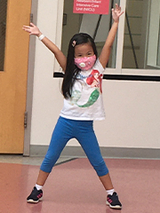Prenatal Surgery for Spina Bifida: Avery’s Story
Prenatal Surgery for Spina Bifida: Avery’s Story
When Katie was pregnant with her second child, a routine prenatal screening led to a diagnosis of spina bifida and, ultimately, the opportunity for Katie and her unborn baby to undergo fetal surgery to repair the defect. Today, 6-year-old Avery loves reading, drawing, and watching K-pop videos and practicing the dance moves with her big sister.

Katie was 18 weeks pregnant when a prenatal screening showed high levels of alpha-fetoprotein in her blood, which can indicate a neural tube defect. An ultrasound confirmed that her baby had spina bifida, a birth defect in which a section of the spinal cord and spinal nerves are exposed through an opening in the back.
Katie’s local obstetrician near their home in Maryland recommended she and her husband, Daniel, see a specialist at the Center for Fetal Diagnosis & Treatment at Children’s Hospital of Philadelphia (CHOP). The team at CHOP are pioneers in fetal surgery and have cared for thousands of expectant mothers carrying babies with suspected spina bifida.
Until then, Katie’s only knowledge of spina bifida came from an old movie. But unlike many parents faced with a frightening diagnosis, Katie stayed away from the internet, knowing whatever she found would likely upset her. She knew she would be better off waiting to learn about the condition and her options for treating it from the medical professionals at CHOP.
Two weeks after the diagnosis, Katie and Daniel left their then 6-year-old daughter with her grandmother and made the drive to CHOP.
A candidate for fetal surgery
Katie underwent two days of detailed evaluations where the team of fetal imaging specialists confirmed that Avery had myelomeningocele, the most severe form of spina bifida. The couple learned that because of the early diagnosis, the L4 location of the lesion on the baby’s spine, and other factors, Katie and Avery qualified for prenatal surgery.
Research shows that fetal surgery for spina bifida has better outcomes than operating after a baby is born. During gestation, the exposed spinal nerves are damaged by amniotic fluid. It’s not uncommon for a baby that kicks its legs in utero to have lost that function by birth. Prenatal repair improves mobility and the chance that a child will be able to walk. It also greatly reduces the need for a shunt to divert fluid from the brain, a common complication caused by hydrocephalus.
Daniel was understandably nervous about the surgery, but despite it being a big decision, Katie says she never questioned it. They scheduled the operation for just after New Year’s, 2014.
“I went into everything very hopeful,” remembers Katie. “I think that’s kind of what got me through it. I went into it very confident that it would all work out.”
Repairing spina bifida in utero
CHOP Surgeon-in-Chief N. Scott Adzick, MD, a pediatric neurosurgeon, and a maternal-fetal medicine specialist led the team performing the delicate surgery. The entire procedure took less than 80 minutes, and required a finely-tuned process and expert care for both Katie and Avery.
After opening Katie’s uterus through an incision in her abdomen, the surgeons returned the spinal cord to the spinal canal and closed the opening in the baby’s back. The spinal cord was thus protected from the ravaging effect of amniotic fluid. After the surgery, Katie recovered smoothly. To reduce the risk of preterm labor, she was put on strict bedrest for the first three weeks following surgery. After that, she was allowed limited activity.
For the remainder of her pregnancy, Katie stayed at the Ronald McDonald House with her mother. She was among six women staying there who had also undergone prenatal surgery. It was a support group like no other, she remembers.
Avery makes her second appearance

Katie was scheduled for a c-section at 37 weeks of gestation in CHOP’s Garbose Family Special Delivery Unit (SDU). However, her water broke two weeks ahead of schedule. Katie didn’t know it at the time, but she had suffered a partial placental abruption, a complication in which the placenta separates from the uterus.
Daniel rushed to Philadelphia from Maryland, arriving just in time to see his wife being wheeled into the delivery room. Moments later, Avery arrived by c-section.
“I feel like everything worked out the way it was supposed to work out,” says Katie.
Avery spent nine days in the Newborn/Infant Intensive Care Unit as a precaution, but other than treatment for jaundice, she needed no medical intervention.
Getting stronger every day

Now 6 years old, Avery continues to do well. She does have bladder and bowel problems — common in children with spina bifida — and requires catheterization and mini enemas, but her family manages everything at home. Otherwise, Avery is a typical first-grader who loves to read, draw, and learn K-pop dance moves with her big sister. She is doing well in school and has even jumped ahead in math.
The CHOP team that cared for Avery from the start has high hopes for her future.
“She is getting stronger and stronger as she gets older and there really hasn’t been any limitation to what she can do," says Katie.
Watch the video to see Avery in action a few years back!
Updated November 2020